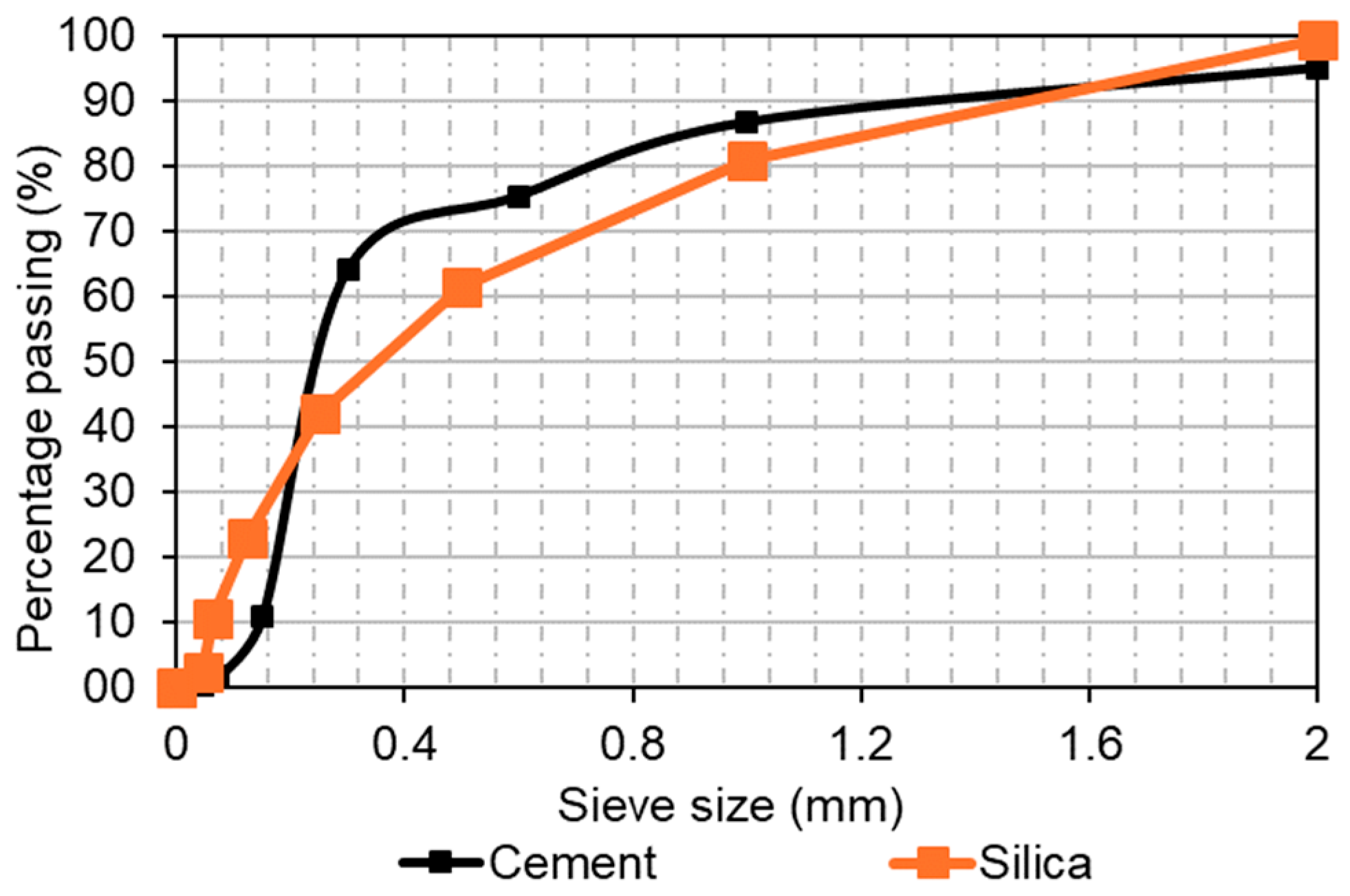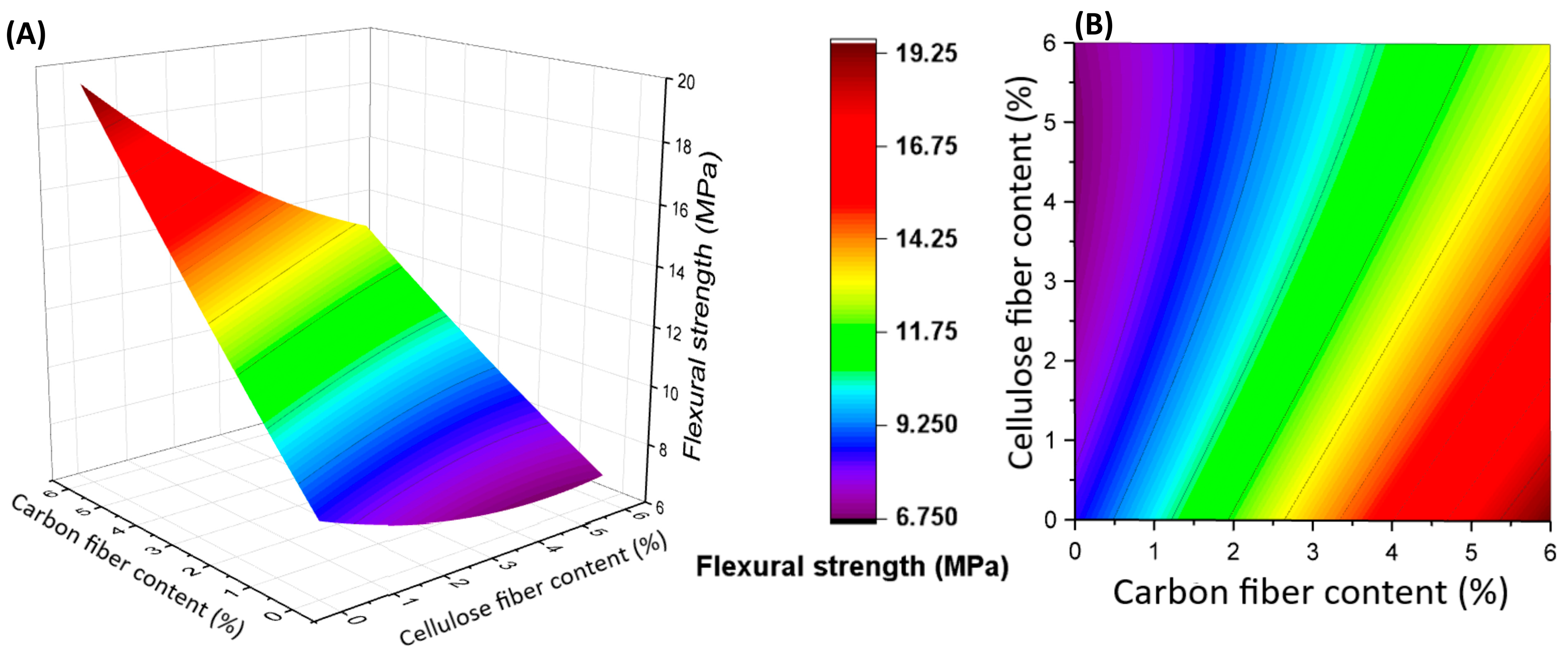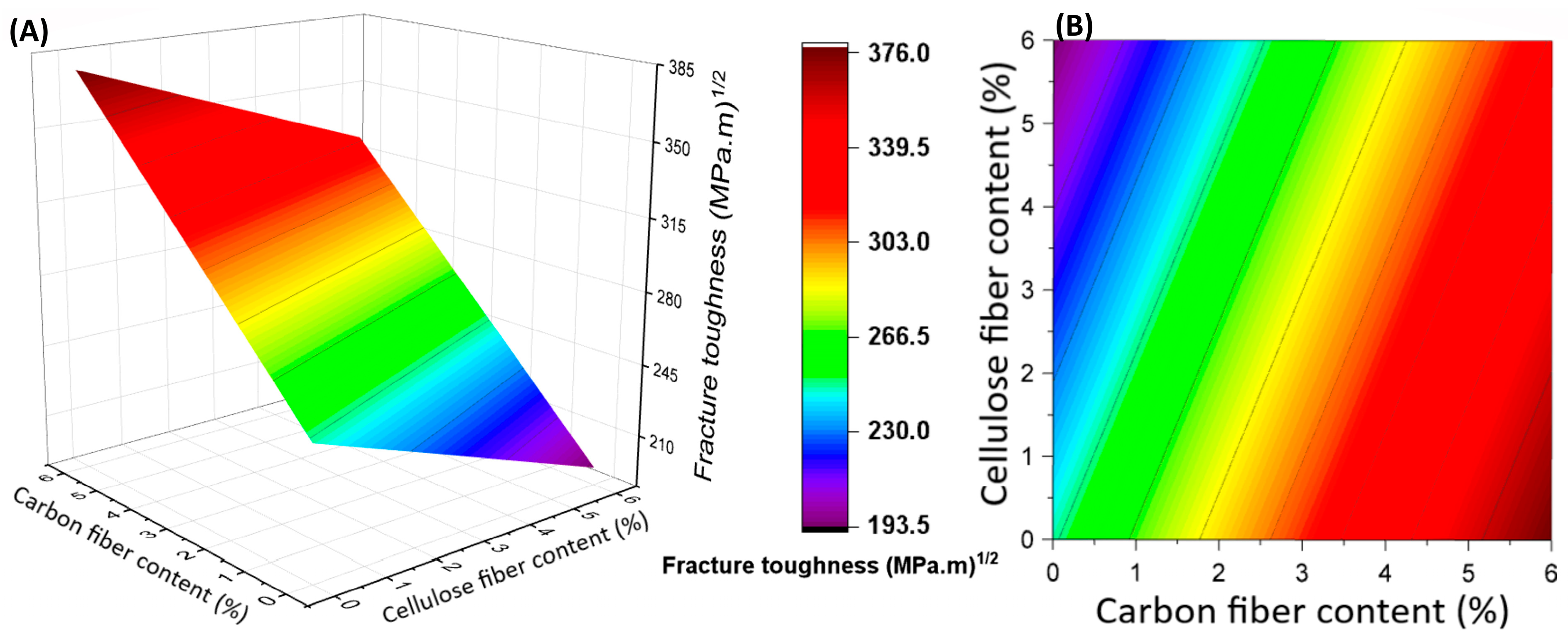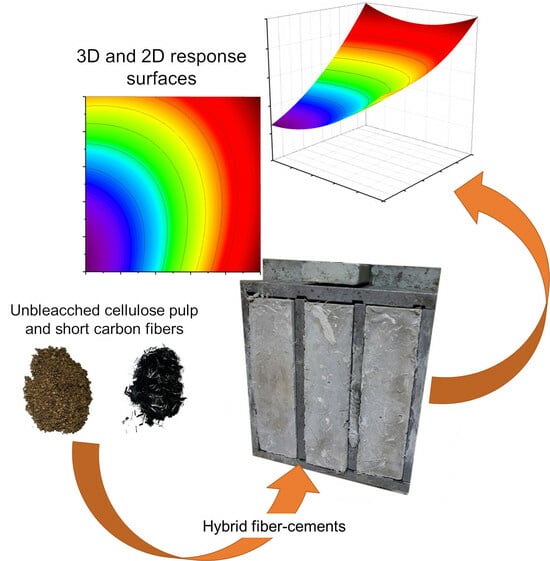Effect of Hybridization of Carbon Fibers on Mechanical Properties of Cellulose Fiber–Cement Composites: A Response Surface Methodology Study
Abstract
1. Introduction
2. Materials and Methods
2.1. Raw Materials
2.2. Fiber–Cement Manufacture
2.3. Characterization of Fiber–Cement Composites
2.4. Mathematical Treatment
3. Results
3.1. Flexural Strength
3.2. Compressive Strength
3.3. Fracture Toughness
4. Conclusions
Author Contributions
Funding
Data Availability Statement
Acknowledgments
Conflicts of Interest
References
- Amiandamhen, S.O.; Meincken, M.; Tyhoda, L. Natural Fibre Modification and Its Influence on Fibre-Matrix Interfacial Properties in Biocomposite Materials. Fibers Polym. 2020, 21, 677–689. [Google Scholar] [CrossRef]
- Ornaghi, H.L.J.; da Silva, H.S.P.; Zattera, A.J.; Amico, S.C. Dynamic Mechanical Properties of Curaua Composites. J. Appl. Polym. Sci. 2012, 116, 2658–2667. [Google Scholar]
- Mohan, T.P.; Kanny, K. Chemical Treatment of Sisal Fiber Using Alkali and Clay Method. Compos. Part A Appl. Sci. Manuf. 2012, 43, 1989–1998. [Google Scholar] [CrossRef]
- Ardanuy, M.; Claramunt, J.; Toledo Filho, R.D. Cellulosic Fiber Reinforced Cement-Based Composites: A Review of Recent Research. Constr. Build. Mater. 2015, 79, 115–128. [Google Scholar] [CrossRef]
- Hamdaoui, O.; Limam, O.; Ibos, L.; Mazioud, A. Thermal and Mechanical Properties of Hardened Cement Paste Reinforced with Posidonia-Oceanica Natural Fibers. Constr. Build. Mater. 2021, 269, 121339. [Google Scholar] [CrossRef]
- Pickering, K.L.; Efendy, M.G.A.; Le, T.M. A Review of Recent Developments in Natural Fibre Composites and Their Mechanical Performance. Compos. Part A Appl. Sci. Manuf. 2016, 83, 98–112. [Google Scholar] [CrossRef]
- Faruk, O.; Bledzki, A.K.; Fink, H.P.; Sain, M. Progress Report on Natural Fiber Reinforced Composites. Macromol. Mater. Eng. 2014, 299, 9–26. [Google Scholar] [CrossRef]
- Tolêdo Filho, R.D.; Ghavami, K.; England, G.L.; Scrivener, K. Development of Vegetable Fibre–Mortar Composites of Improved Durability. Cem. Concr. Compos. 2003, 25, 185–196. [Google Scholar] [CrossRef]
- Wei, J.; Meyer, C. Utilization of Rice Husk Ash in Green Natural Fiber-Reinforced Cement Composites: Mitigating Degradation of Sisal Fiber. Cem. Concr. Res. 2016, 81, 94–111. [Google Scholar] [CrossRef]
- Wei, J.; Meyer, C. Degradation Mechanisms of Natural Fiber in the Matrix of Cement Composites. Cem. Concr. Res. 2015, 73, 1–16. [Google Scholar] [CrossRef]
- Claramunt, J.; Ardanuy, M.; García-hortal, J.A.; Filho, R.D. The Hornification of Vegetable Fibers to Improve the Durability of Cement Mortar Composites. Cem. Concr. Compos. 2011, 33, 586–595. [Google Scholar] [CrossRef]
- Mahdi, S.; Xie, T.; Venkatesan, S.; Gravina, R.J. Mechanical Characterisation and Small-Scale Life-Cycle Assessment of Polypropylene Macro-Fibre Blended Recycled Cardboard Concrete. Constr. Build. Mater. 2023, 409, 133902. [Google Scholar] [CrossRef]
- Alwesabi, E.A.H.; Bakar, B.H.A.; Alshaikh, I.M.H.; Akil, H.M. Experimental Investigation on Mechanical Properties of Plain and Rubberised Concretes with Steel–Polypropylene Hybrid Fibre. Constr. Build. Mater. 2020, 233, 117194. [Google Scholar] [CrossRef]
- He, W.; Kong, X.; Fu, Y.; Zhou, C.; Zheng, Z. Experimental Investigation on the Mechanical Properties and Microstructure of Hybrid Fiber Reinforced Recycled Aggregate Concrete. Constr. Build. Mater. 2020, 261, 120488. [Google Scholar] [CrossRef]
- Wang, L.; Aslani, F. Development of Self-Sensing Cementitious Composites Incorporating CNF and Hybrid CNF/CF. Constr. Build. Mater. 2021, 273, 121659. [Google Scholar] [CrossRef]
- Da Cruz, J.A.; Ornaghi, H.L.; Amico, S.C.; Bianchi, O. Predicting Viscosity in Polyurethane Polymerization for Liquid Composite Molding Using Neural Networks and Surface Methodology. Polym. Bull. 2023. [Google Scholar] [CrossRef]
- Manral, A.; Singh, R.; Ahmad, F.; Das, P.P.; Chaudhary, V.; Joshi, R.; Srivastava, P. Multi-objective optimization of mechanical properties of chemically treated bio-based composites using response surface methodology. Compos. Part C 2023, 10, 100337. [Google Scholar] [CrossRef]
- Aramburu, A.B.; Rossetto, H.L.; Magalhães, W.L.E.; Trindade, G.H.; de Avila Delucis, R. Cement Matrix Reinforced with Microfibrillated Cellulose Treated with Furfuryl Alcohol. Cellulose 2023, 30, 10297–10312. [Google Scholar] [CrossRef]
- Tawfik, A.; Abd-El-Razik, R.A. Design, Fabrication, and Characterization of Distinguished Lightweight and Sustainable Building Materials. J. Build. Eng. 2022, 46, 103712. [Google Scholar] [CrossRef]
- ISO Standard No. 12135:2021; Metallic Materials—Unified Method of Test for the Determination of Quasistatic Fracture Toughness. International Organization for Standardization: Geneva, Switzerland, 2021.
- Rostamiyan, Y.; Fereidoon, A.; Mashhadzadeh, A.H.; Ashtiyani, M.R.; Salmankhani, A. Using Response Surface Methodology for Modeling and Optimizing Tensile and Impact Strength Properties of Fiber Orientated Quaternary Hybrid Nano Composite. Compos. Part B Eng. 2015, 69, 304–316. [Google Scholar] [CrossRef]
- Flores, A.; Albertin, A.; de Avila Delucis, R.; Amico, S.C. Mechanical and Hygroscopic Characteristics of Unidirectional Jute/Glass and Jute/Carbon Hybrid Laminates. J. Nat. Fibers 2023, 20, 2178586. [Google Scholar] [CrossRef]
- Lima, P.R.L.; Santos, R.J.; Ferreira, S.R.; Toledo Filho, R.D. Characterization and Treatment of Sisal Fiber Residues for Cement-Based Composite Application. Eng. Agríc. 2014, 34, 812–825. [Google Scholar] [CrossRef]
- Ballesteros, J.E.M.; Santos, S.F.; Mármol, G.; Savastano, H.; Fiorelli, J. Evaluation of Cellulosic Pulps Treated by Hornification as Reinforcement of Cementitious Composites. Constr. Build. Mater. 2015, 100, 83–90. [Google Scholar] [CrossRef]
- Ballesteros, J.E.M.; Mármol, G.; Filomeno, R.; Rodier, L.; Savastano, H.; Fiorelli, J. Synergic Effect of Fiber and Matrix Treatments for Vegetable Fiber Reinforced Cement of Improved Performance. Constr. Build. Mater. 2019, 205, 52–60. [Google Scholar] [CrossRef]
- Ferreira, S.R.; Lima, P.R.L.; Silva, F.A.; Toledo Filho, R.D. Effect of Sisal Fiber Hornification on the Fiber-Matrix Bonding Characteristics and Bending Behavior of Cement Based Composites. Key Eng. Mater. 2014, 600, 421–432. [Google Scholar]
- Poggiali, J.; Maia, L.; Rodrigues, C.D.S. Hornification on Vegetable Fibers to Improve Fiber-Cement Composites : A Critical Review. J. Build. Eng. 2022, 48, 103947. [Google Scholar] [CrossRef]
- Lima, P.R.L.; Santos, H.M.; Camilloto, G.P.; Cruz, R.S. Effect of Surface Biopolymeric Treatment on Sisal Fiber Properties and Fiber-Cement Bond. J. Eng. Fibers Fabr. 2017, 12, 59–71. [Google Scholar] [CrossRef]
- Pehanich, J.L.; Blankenhorn, P.R.; Silsbee, M.R. Wood Fiber Surface Treatment Level Effects on Selected Mechanical Properties of Wood Fiber-Cement Composites. Cem. Concr. Res. 2004, 34, 59–65. [Google Scholar] [CrossRef]
- Lertwattanaruk, P.; Suntijitto, A. Properties of Natural Fiber Cement Materials Containing Coconut Coir and Oil Palm Fibers for Residential Building Applications. Constr. Build. Mater. 2015, 94, 664–669. [Google Scholar] [CrossRef]
- Gwon, S.; Cheol, Y.; Shin, M. Effect of Plant Cellulose Microfibers on Hydration of Cement Composites. Constr. Build. Mater. 2021, 267, 121734. [Google Scholar] [CrossRef]
- Gao, J.; Sha, A.; Wang, Z.; Hu, L.; Yun, D.; Liu, Z.; Huang, Y. Characterization of Carbon Fiber Distribution in Cement-Based Composites by Computed Tomography. Constr. Build. Mater. 2018, 177, 134–147. [Google Scholar] [CrossRef]
- Chen, L.; Yin, X.; Fan, X.; Chen, M.; Ma, X.; Cheng, L.; Zhang, L. Mechanical and Electromagnetic Shielding Properties of Carbon Fiber Reinforced Silicon Carbide Matrix Composites. Carbon N. Y. 2015, 95, 10–19. [Google Scholar] [CrossRef]
- Yan, S.; He, P.; Jia, D.; Yang, Z.; Duan, X.; Wang, S.; Zhou, Y. Effect of Fiber Content on the Microstructure and Mechanical Properties of Carbon Fiber Felt Reinforced Geopolymer Composites. Ceram. Int. 2016, 42, 7837–7843. [Google Scholar] [CrossRef]





| Cellulose/Carbon | Cement | Silica | Cellulose | Carbon | Water | Superplasticizer |
|---|---|---|---|---|---|---|
| 6% 0% | 1955 | 255 | 97.75 | 0 | 926.5 | 8.5 |
| 0%/6% | 1955 | 255 | 0 | 97.75 | 926.5 | 8.5 |
| 3%/3% | 1955 | 255 | 48.87 | 48.87 | 926.5 | 8.5 |
| 4.5%/1.5% | 1955 | 255 | 65.16 | 32.58 | 926.5 | 8.5 |
| 1.5%/4.5% | 1955 | 255 | 32.58 | 65.16 | 926.5 | 8.5 |
| Parameter | Z0 | a | b | c | D | F | Degrees of Freedom | Residual Sum of Squares | Reduced Chi-Sqr | R2 |
|---|---|---|---|---|---|---|---|---|---|---|
| Flexural strength | 8.465 | −0.7245 | 1.711 | 0.07679 | 0.02091 | −0.1370 | 29 | 25.7 | 0.105 | 0.995 |
| Standard error | 0.4099 | 0.1970 | 0.2031 | 0.02789 | 0.02790 | 0.02407 |
| Parameter | Z0 | a | b | c | D | F | Degrees of Freedom | Residual Sum of Squares | Reduced Chi-Sqr | R2 |
|---|---|---|---|---|---|---|---|---|---|---|
| Compressive strength | 21.769 | 0.1370 | 1.003 | 0.1553 | 0.1593 | −0.02028 | 34 | 2.398 | 0.939 | 0.999 |
| Standard error | 0.09118 | 0.05283 | 0.05437 | 0.008080 | 0.008930 | 0.007360 |
| Parameter | Z0 | a | b | c | D | F | Degrees of Freedom | Residual Sum of Squares | Reduced Chi-Sqr | R2 (COD) |
|---|---|---|---|---|---|---|---|---|---|---|
| Fracture toughness MPa·m1/2 | 2473 | −8.969 | 21.72 | - | - | - | 32 | 5.045 × 10−25 | 0.999 | 0.999 |
| Standard error | 3.582 × 10−13 | 7.371 × 10−14 | 7.816 × 10−14 | - | - | - |
Disclaimer/Publisher’s Note: The statements, opinions and data contained in all publications are solely those of the individual author(s) and contributor(s) and not of MDPI and/or the editor(s). MDPI and/or the editor(s) disclaim responsibility for any injury to people or property resulting from any ideas, methods, instructions or products referred to in the content. |
© 2024 by the authors. Licensee MDPI, Basel, Switzerland. This article is an open access article distributed under the terms and conditions of the Creative Commons Attribution (CC BY) license (https://creativecommons.org/licenses/by/4.0/).
Share and Cite
Insaurriaga, G.L.; Gomes, C.C.; Ribeiro, F.V.; Calegaro, G.L.; Silveira, T.A.; Cruz, L.F.; Cruz, J.A.; Amico, S.C.; Delucis, R.A. Effect of Hybridization of Carbon Fibers on Mechanical Properties of Cellulose Fiber–Cement Composites: A Response Surface Methodology Study. C 2024, 10, 41. https://doi.org/10.3390/c10020041
Insaurriaga GL, Gomes CC, Ribeiro FV, Calegaro GL, Silveira TA, Cruz LF, Cruz JA, Amico SC, Delucis RA. Effect of Hybridization of Carbon Fibers on Mechanical Properties of Cellulose Fiber–Cement Composites: A Response Surface Methodology Study. C. 2024; 10(2):41. https://doi.org/10.3390/c10020041
Chicago/Turabian StyleInsaurriaga, Gabriel L., Cristian C. Gomes, Felipe V. Ribeiro, Gustavo L. Calegaro, Thamires A. Silveira, Lóren F. Cruz, Joziel A. Cruz, Sandro C. Amico, and Rafael A. Delucis. 2024. "Effect of Hybridization of Carbon Fibers on Mechanical Properties of Cellulose Fiber–Cement Composites: A Response Surface Methodology Study" C 10, no. 2: 41. https://doi.org/10.3390/c10020041
APA StyleInsaurriaga, G. L., Gomes, C. C., Ribeiro, F. V., Calegaro, G. L., Silveira, T. A., Cruz, L. F., Cruz, J. A., Amico, S. C., & Delucis, R. A. (2024). Effect of Hybridization of Carbon Fibers on Mechanical Properties of Cellulose Fiber–Cement Composites: A Response Surface Methodology Study. C, 10(2), 41. https://doi.org/10.3390/c10020041









